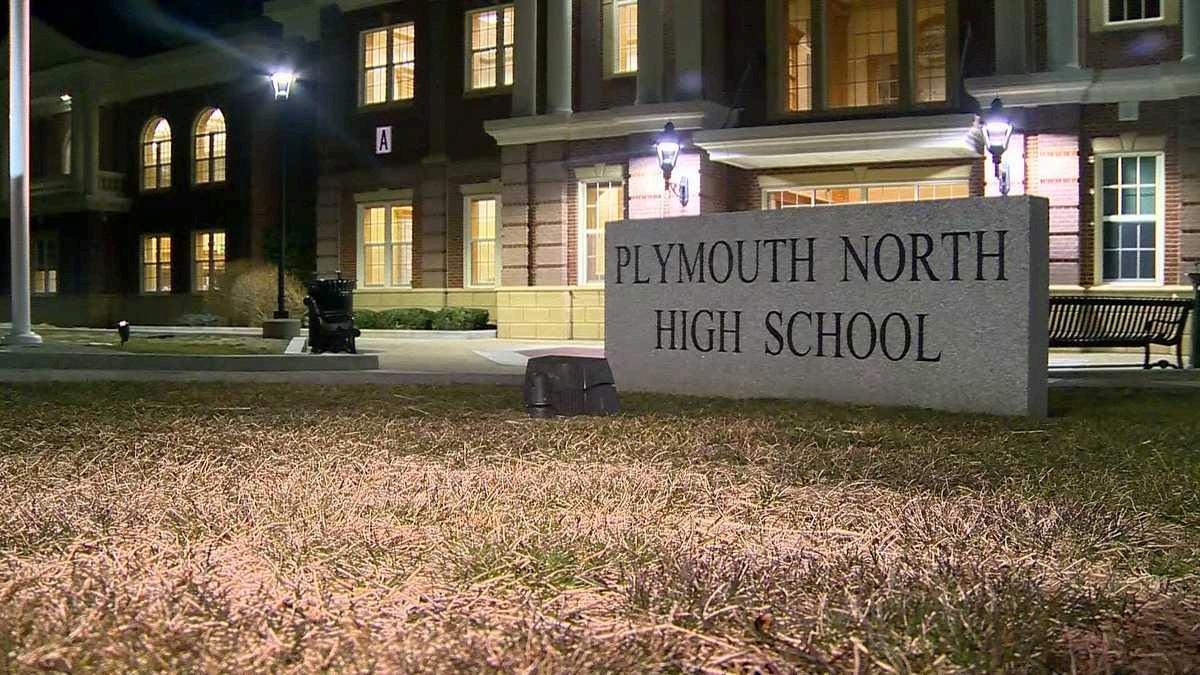

The Eagle
Plymouth Schools Revamp Tech Program Admissions for Fairer Access
Insight into changes made to ensure that all students have a chance to enroll in Plymouth Public Schools’ tech programs
By Trace Flora
Plymouth Public Schools is shaking up how students are admitted into its technical education programs, and the change has sparked debate among teachers and students alike The new lottery-based admissions system, which will go into effect next school year replaces the selective process that once weighed grades, attendance, and behavior, aiming to make access fairer to everyone
The shift follows a statewide mandate from the Massachusetts Department of Elementary and Secondary Education requiring all public schools to adopt random lottery admissions
Supporters say the change will eliminate barriers that previously kept some students out, while critics argue it could lower motivation and allow less committed applicants to take seats from those who have worked hard to earn them
“This wasn’t a local decision,” Mr Mark Duffy, the College, Career, and Technical Education (CCTE) Director, said “We are required and mandated by the State of Massachusetts, the Department of Elementary and Secondary Education and the Board of Elementary and Secondary Education They made a regulation change that requires all vocational schools in the Commonwealth to now use a lottery for admissions ”
Under the new system, grades and teacher recommendations no longer factor into who gets in, rather, students receive one lottery entry – or two if they have fewer than 27 absences during middle school
“The only criteria you are allowed to use is attendance from day one of grade seven to the end of the first semester of grade eight,” Mr Duffy said
Teachers have viewed the issue from multiple angles Mr Carl Nielsen, the Engineering Technology teacher at Plymouth North, has witnessed firsthand how competitive the old process could be
“For years and years I’ve been told that Engineering Technology is one of the most competitive programs with a very long waitlist we were getting students who excel, but I felt that the system was broken because some students who would really benefit didn’t get in ” he said
Still Mr Nielsen believes the lottery system may not solve the issue “I do think reform was needed,” he said “But I don’t think the lottery is the answer – it might actually get worse in terms of who ultimately gets into the program ”
He suggested a middle ground – requiring a letter of interest from applicants to ensure students have a genuine desire to join
“Students should have a vested interest in getting into a four-year program like this,” he said “Right now, all they have to do is sign a piece of paper”

Other teachers see more potential in the new system’s goals, even if they acknowledge the uncertainty ahead Mrs Karen Mullen, who teaches Allied Health, said that while the previous system did shape the student body, it also ensured clarity and fairness
“When there are not enough seats in our programs for every student entering high school, there needs to be a way to create fair and equal access Our current admission criteria is available to students and parents; it is not left to chance,” Mullen said
Still she recognizes that the lottery could broaden opportunities though not without drawbacks
“I think that the change will create opportunities for students who may have previously been placed on a waitlist,” she said “However, students with genuine interest in a program face the reality of not being admitted ”
For Mrs Mullen, success in Allied Health depends on more than just grades
“Students need grit, compassion, and a genuine interest in helping others,” she said “It takes dedication and a lot of work to succeed ”
Meanwhile Mrs Jessica Burns who teaches Marketing, views the new process as a potential step toward inclusivity, and she noted that the old system sometimes excluded students who might thrive in vocational settings despite academic or behavior struggles
“Not all students are successful in academics but prove to be better suited for trades or other pathways of life,” she said “Limiting students who truly need the vocational pathway because of academics or minor behavior concerns isn’t giving them the opportunity they may need to be successful beyond high school ”
Even so, she expressed some concern that the new process could attract students without genuine interest
“I fear that some students will throw their name in the lottery who may not truly be interested,” she said “There should be interviews or something to measure student interest before accepting them ”
Mrs Burns remains optimistic however that the change could help level the playing field
“I’m hopeful the new weighted lottery is a step in the right direction,” she said “It may give access to students whose strengths aren’t academic but who truly want to be part of our programs ”
Some students have raised concerns about the new process as well Michael Cella, a junior taking Engineering Technology, said he worries that the lottery may take away opportunities from motivated students
“For the people who worked for this, who wanted to be in tech, I don’t think it’s fair if someone who just fills out a form gets in instead But I do think more people will try to apply now that it’s easier,” he said
Despite his criticism, Cella praised the program for shaping his future goals
“I’ve learned more in engineering than any other class,” he said “It’s made me realize how much I want to do something in STEM in the future
Though opinions vary, both staff and students agree that interest in Plymouth’s tech programs continues to grow faster than available seats
“The lottery guarantees a random process,” said Mr Duffy “But the problem still exists that we don’t have enough spots for the demand –that’s the real issue ”

Junior Mia Bows ripping plywood on table saw Photo courtesy of Dave South
Freshman learning to drive nails Photo courtesy of Dave South
Plymouth Public Schools Virtual Classes Expand Learning Opportunities for Students
Insight into the hundreds of classes students can sign up for
By Brady Shea
VHS classes even have work arounds for activities that would be hard to complete outside of a typical classroom environment For example, labs in Science classes or socratic seminars in English classes
fhen attending a public high school, most students are limited to the classes their fffffffffschools offer, and if a class doesn’t fit into their schedule, they are out of luck However, Plymouth Public Schools have found a workaround to benefit students’ interests The Plymouth Public School District provides students with as many resources as they can to help students set up a career path in a field they are interested in One way of doing this is allowing high school students to take virtual high school classes (VHS Classes) as a period in the school day
Students are able to sign up for a VHS class for two different reasons - the class they want to take is not offered at their school, or the class they want to take does not fit into their schedule In both cases, students are able to get in contact with their guidance counselor to register for the class
“I receive course requests from guidance Near the end of the school year I try and meet with the students and go over the expectations,” Mrs Debra Foreaker, Plymouth Public Schools VHS Site Coordinator/Consortium said VHS offers over 200 courses varying from AP classes to electives like American Sign Language (ASL), Astronomy, and Video Game Design
Senior, Fanoula Venetis, currently enrolled in American Sign Language, said, “As I grew up I would practice small signs here and there and was eager to learn in case I came across a deaf or hard of hearing person and wanted to communicate I wanted to learn more as I accumulate languages into my daily life ”
While students may think that having a period to sit in the library to work is a “free” period, students are warned that these online classes can be rigorous
“AP courses require a commitment of 10-15 hours a week in the VHS classroom environment For VHS Honors students the expectation is 8-10 hours in the learning environment ” Mrs Foreaker said
When taking a VHS course, the work week is very different from those of a regular class “School weeks run Tuesday to Tuesday You have all work assigned to you on Tuesday, that is due the next Tuesday All work is frontloaded ” said Molly St Gelais, a current Plymouth North Senior enrolled in VHS AP Physics because of a scheduling conflict
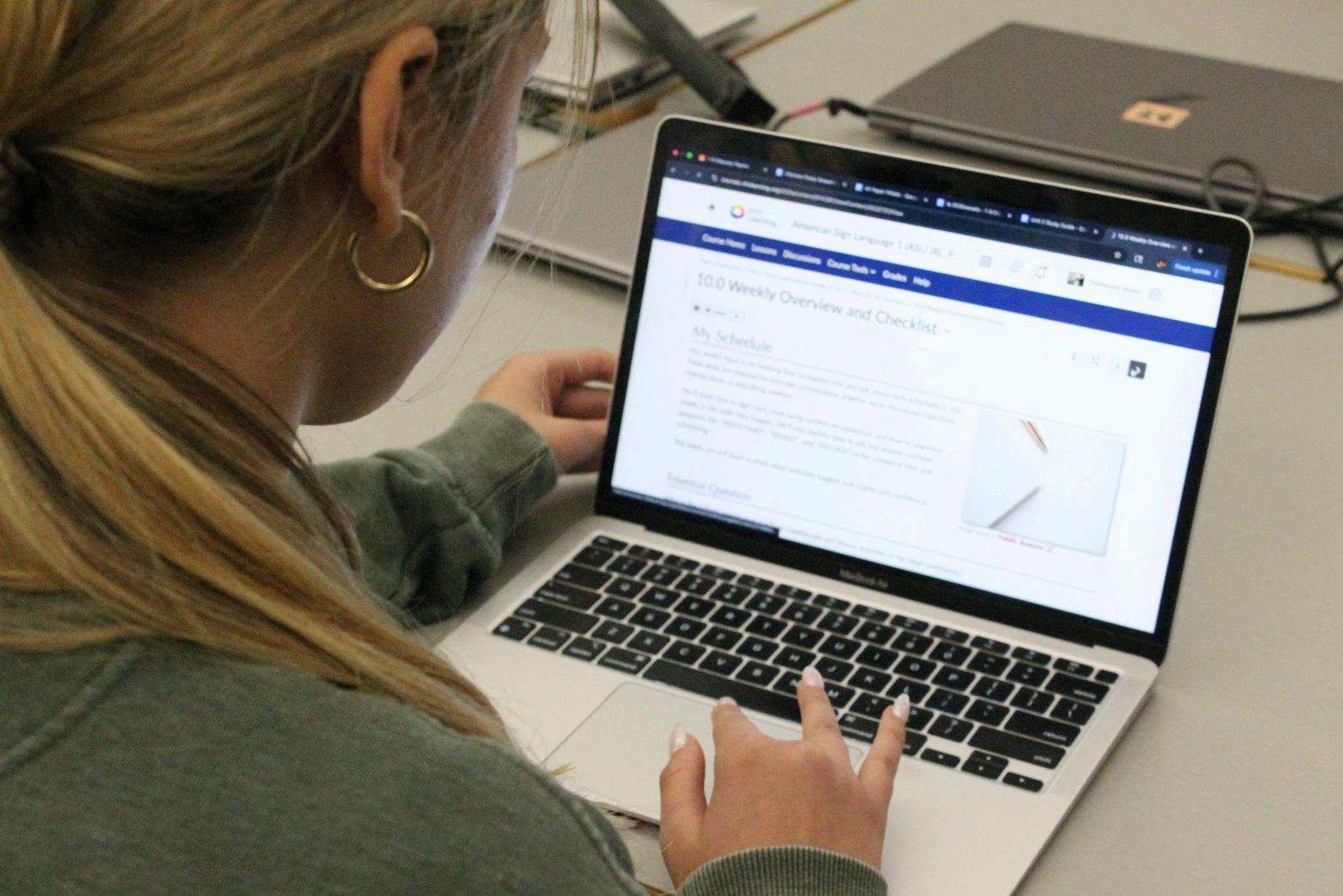
“It is different because you don't have a teacher telling you to do this assignment today Everything is due on the same day, 7 days to complete 10 assignments, and I can complete them however I want ”
“At the beginning of the course, usually in the third week the students receive Lab Kits to bring home and do all the lab work,” Mrs Foreaker said “Students must post pictures of the setup and pictures of themselves doing the lab work ”
When taking an online course it is difficult to navigate material that is not easy to grasp Fortunately, VHS classes provide many resources to help students in substitution of a teacher not being there in person to help clarify questions
“Oftentimes we are given resources to websites where we can learn more information or practice skills but if there is an issue with not understanding, I can easily go look up a work to see a visual from another source,” Venetis said
Although many may think that taking a VHS course is unfavorable to taking a class with an instructor students enrolled in VHS say otherwise
“I actually feel like I am at an advantage compared to others taking AP Physics because the VHS curriculum is pre-planned and is set in stone I know that I am going to get through all the material where in person classes teachers will sometimes spend more time on concepts that students struggle to understand,” said St Gelais
Students in the Plymouth Public School District are lucky enough to have the opportunity to take VHS classes that are not offered in person, or when they do not fit in a student's schedule VHS classes allow students who need to take prerequisite introductory classes for college to take the course even if not offered in the school district
New Exploring Education takes charge at Plymouth North
S WInsight into the fresh new elective that gives students direct experience and a realistic glimpse on teaching
tarting off the new school year strong, a new elective class, “Exploring Education ” is now offered to students at Plymouth North interested in pursuing education in future, sparking a curiosity among students
Many schools within Massachusetts, such as Plymouth South High School offer a technical program called “The preschool program” which allows high school students to be exposed to a unique environment in which they can get handson experience with teaching
Unfortunately, most schools do not offer an elective or technical program for students potentially interested in teaching, resulting in many students, particularly at Plymouth North, feeling unsure about their future endeavors
Deriving inspiration from the program, Mr Nicholas Davis, a French teacher at Plymouth North came up with the idea to create a new elective in order to instruct and enlighten students' curiosities about the skills and mindset needed to become a proper educator “I had something like this in high school,” Mr Davis said “ I thought it could be beneficial, I want the elective to be the most beneficial as possible ”
The class is run in a very practical content-based manner, in which Mr Davis allows for students to participate in and lead small mini activities based off of an education field of their choice (Elementary, Middle School, etc) After doing the activity as a class, Mr Davis teaches the class the thematic, and philosophical principles embedded within teaching
By Paige Robertson
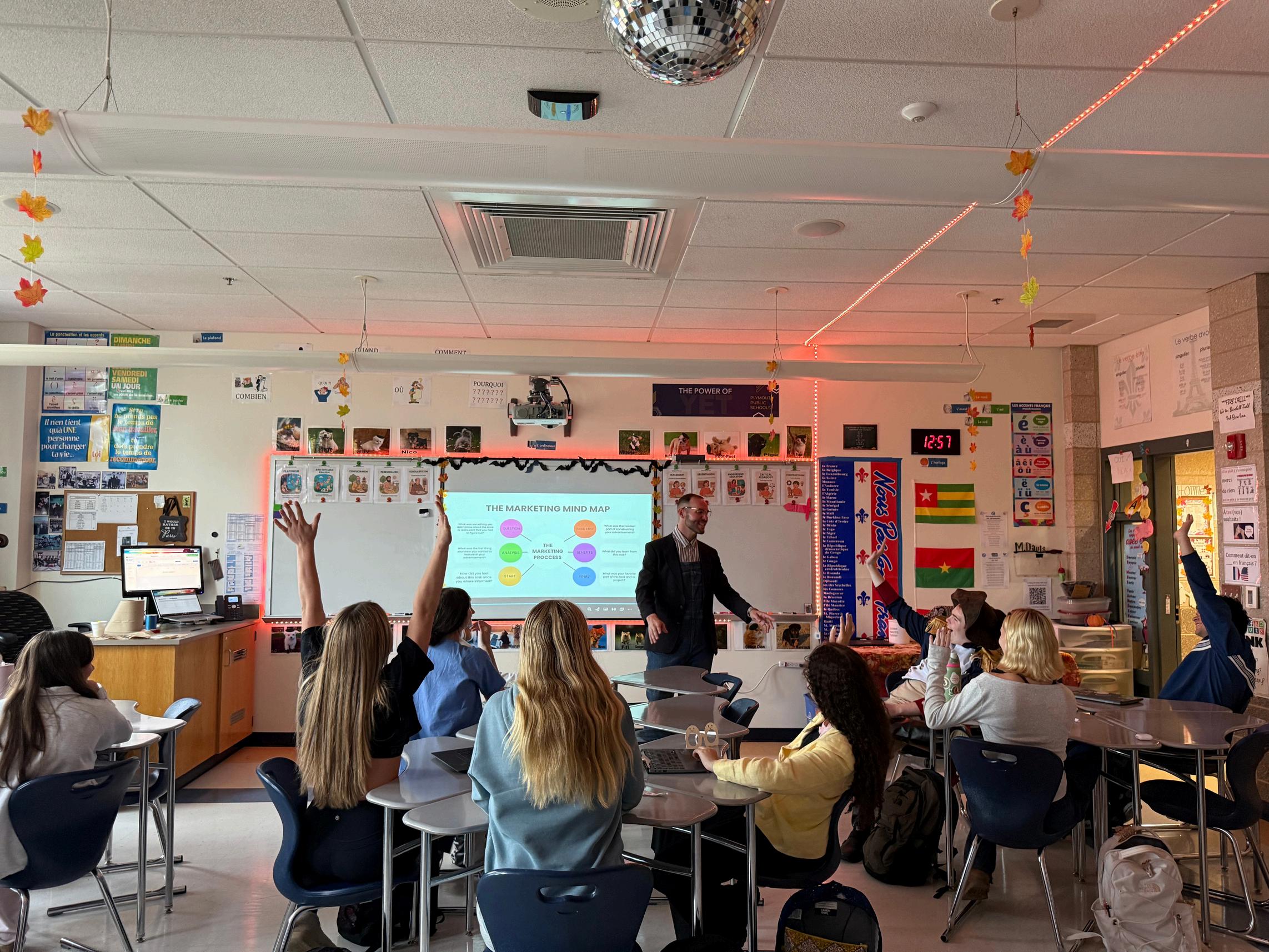
PhototakenbyMr NicholasDavis
“So what will happen everyday is we’ll come to class and there will be a bell ringer everyday, and one person will pretend to be like a teacher for about 10 minutes,” said Zoe Melody, a current Plymouth North High School senior enrolled in the class At first, Mr Davis had expressed worry about the class being unsuccessful, as the percent of teachers dropping out of the profession According to the National Education Association, due to salary, lack of support, and harsh behavior from students,
teachers quitting the profession has increased by 22% in 2024
“I think it’s the best job, but it’s very tiring,” said Mr Davis
“Most young teachers will quit after five years, so that’s a lot of time and resources So if the students can get a realistic view of what it’s like in this field, I think I have done my job ”
While some might discover that teaching isn’t necessarily for them throughout taking this course, many students currently taking the class have expressed gratitude and a deeper interest in wanting to pursue education
“It’s helped me think about my future more,” said Madeline Woomer, a Plymouth North High School student currently enrolled in Exploring Education “It’s made me want to be a teacher more, and I think it’s a really great class to take if you are on the fence about teaching ”
“It’s definitely like a good course to take for people that are considering you know, maybe I want to study education in college, because it can really help to sort of gauge like, hey, these are all these things that you may not realize or may not think about are components of teaching, but they're very real, ” said student Zoe Melody Students enrolled in Exploring Education will start having guest speakers, many of whom will be current teachers and faculty at Plymouth North come in to give their own perspective and journeys of teaching At the start of the second term students will start to form their own lesson plans and fully teach a session to the class in order to get the full effect of the teaching experience
“It is not for the faint of heart but it is the best job I truly cannot think of doing anything other than teaching It's very special And that positive outweighs the negatives ” said Mr Davis
It’s not a secret that at Plymouth North, the teachers care immensely about their students yet it’s inspiring to see how one teacher's own interest became an elective class that multiple students may credit as their humble start to their own teaching careers
PhototakenbyMeganHolleman
Mr Davis teaching an Exploring Education class
VHS student Fanoula Venetis checking her online assignments
eturning to school after prolonged hasjkahh physical or psychiatric absences can khjsdjhkjhbe an uncertain road for many students For years, those first steps back were often met with confusion, anxiety, and isolation
At Plymouth North High School the bryt program, which stands for Bridging Resilient Youth in Transition, serves to give students the resources and stability they need to grow confidence and belonging Now, the bryt program, which is in its second year, is working to improve efficiency to provide the best personalized and compassionate care for returning students
Principal Peter Parcellin recalled the hardships students faced transitioning back to school prior to bryt “We were seeing a lot of kids leave school for extended periods of time and really struggle to transition back,” Parcellin said “Just stepping foot in the building is a stressor but trying to coordinate makeup work, connect with teachers and counselors, and reengage your friends is very overwhelming ”
Recognizing that students needed more than just goodwill and leniency for their return, Mr Parcellin and Dr Stacey Rogers successfully applied for a grant from the Department of Mental Health Through the grant they discovered that the bryt model already had success in school districts around Massachusetts
“It had been used in places I respected, it was well funded, and it answered all the questions we were trying to answer for kids,” Mr Parcellin said
The school’s academic coordinator for bryt, Ms Beth Keane, recognized the program as a bridge that meets students where they are and supports them as they return to the classroom
PhototakenbyMeganHolleman
“Bryt takes kids that are either coming out of a medical or psychiatric hospitalization, or who are chronically absent, and helps them transition from where they were to where they're going next,” Keane said “That might be back into North full time into a special education or GED program or a different program altogether”
Ms Keane works directly with students and their teachers, identifying which assignments students are responsible for completing, which assignments will be excused and how to help them catch up
“We build lists of what each student needs to complete and then create structured time for them to work,” said Keane
The Bridge Back: Behind The Program
Helping Plymouth North's Students Transition Back To School
Bryt, a statewide transition program implemented at Plymouth North High School, is changing the way the school community welcomes back students returning from extended absences
By Aaron Silva
As of October 2025, about 24 students have participated in the program since its creation “We had between 17 to 19 last year and we've already had five so far this year ” Ms Keane said "We had a much slower entry last year, so now that we’ve been up and running for a year, we’re getting more kids, and we re getting them faster What distinguishes bryt from other initiatives is its dual concentration: the stabilization of mental health and the support of students' academic progress Students in bryt meet with an adjustment counselor frequently, sometimes daily upon entry, and gradually learn to be independent and return to their core classes
“In bryt, you're not just solving immediate problems ” Ms Keane said "You're learning the skills you need to function within the school, things like distress tolerance, how to handle discomfort, and how to stay motivated even when you don't want to be here ”
For Ms Ann Marie Fahey, one of the adjustment counselors at Plymouth North the greatest strength of bryt lies in the community it buildsthat is, a community that works toward recovery rather than rigid routines
“If a student’s been out for weeks or months coming back to a full school day can be a shock to the system,” Ms Fahey said “That’s why the bryt room is so important - it’s a calm, supportive space that lets students ease back into the school environment ”
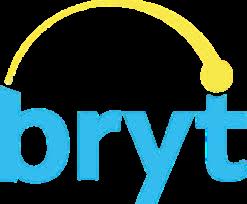
Prior to bryt, there was no formal cohesive process for reentry to school Reintegration relied on a patchwork of guidance counselors, teachers, clinicians and students “We had staff trying to coordinate individually, but there was no single system Kids would sink because nobody had all the answers - and staff were frustrated because they didn’t know how to help,” Mr Parcellin said bryt solved this issue by consolidating support systems under one plan “Now, with Ms Keane managing the academic piece and Ms Carberry and I supporting students' mental health everything is under one umbrella We have the ability to customize a plan around each student's needs,” Ms Fahey said “Each student's plan is personalized, some return faster, others take more time ” Ms Fahey also noted that the biggest impact of bryt goes beyond individual recovery The program has influenced how staff and teachers view their role in a student's overall wellbeing and recovery
“Most of what we do here during the school day isn't strictly teaching, it's making connections with kids,” Ms Fahey said “Students will perform better longer if staff members have a good connection with them They're going to remember that you're a good teacher if you were a good connector”
As the program pushes through its second operational year at North, Mr Parcellin is excited about the broader impact bryt is having and will continue to have on the school “If you create little successes in one spot, usually that will start to ripple out,” he said
That effect is already evident The bryt model has influenced changes in tutoring, guidance cooperation and special education “Tutoring used to be a very similar situation and now we re putting all the tutoring in one spot One person is coordinating it all, and the success we saw on bryt is helping us have way more success with kids who need tutoring ” Mr Parcellin said Beyond logistics, Mr Parcellin frames the bryt program as a more universal educational philosophy
People want to look at schools as factories, but this is much more like creating art,” he said “We help mold each student into who they want to become The answers are different for every person and trying to do that takes time effort, patience, and passion That's what bryt helps make possible ”
Google Gemini coming soon to Plymouth North
Insight into the oncoming introduction of Google Gemini, a type of artificial intelligence, in the Google Classroom workspace
By Megan Holleman
Google Gemini is an AI tool ffff ffffthat was launched in February 2024 in response to Open AI’s popular ChatGPT Plymouth Public Schools' plan is for Google Gemini to be introduced during the second semester of this school year but no official date has been confirmed
With the introduction of Google Gemini, some teachers worry about the morals of allowing AI in school
PhototakenbyMr NicholasDavis
“It can create content that could have taken me a long time to create,” said Mr Jeffrey Hudson, Technology Integration Specialist at North He notes that AI has its uses in expanding the mind, showing new possibilities to enhance creativity
It can also function as an assistant for learning,” said Mr Hudson The Gemini resource can take in numbers and data to process giving back fully realized data sets in a fraction of the time it would take a human
However, even with these benefits artificial intelligence has been a controversial topic as of late, considering its rapid growth in the past three years
“My practice has changed as an educator because of AI,” said Dr Roselyn Farren ELA Teacher at North
“It’s hard work to think for yourself and to develop a complex thought and it's really, really not hard work to just put a prompt into ChatGPT”
A worry with AI is its ability to take away free thinking abilities
Teachers like Dr Farren are concerned that with the direction artificial intelligence is taking, it could possibly hinder the minds of the future generations It is not difficult to see how generative AI could contribute to the damage of our critical thinking skills
Yet, Dr Farren said, “there are contexts where it's enormously helpful and productive ”
As AP Computer Science teacher, Mr Alexandre Cardoso, said, ”the message I always have [for students] is that whatever AI has accomplished for you, you should think that you could have done the task yourself ”
Mr Cardoso, as a computer science teacher, sees the many benefits in AI and notes how it should be used in a classroom
“We are enforcing the fact that the answers aren't being answered by AI instead they are being answered by the students in a controlled setting,” said Mr Cardoso
Other STEM teachers at North see the benefits of using Google Gemini in teaching their students
The other day I used it to get some input on a future lesson,” said Mr Derek Strohschneider, Science teacher at North “I haven't explored the depths of it but I see the value in it,”
Mr Strohschneider along with other teachers are still discovering the full potential of AI but acknowledge the use of it
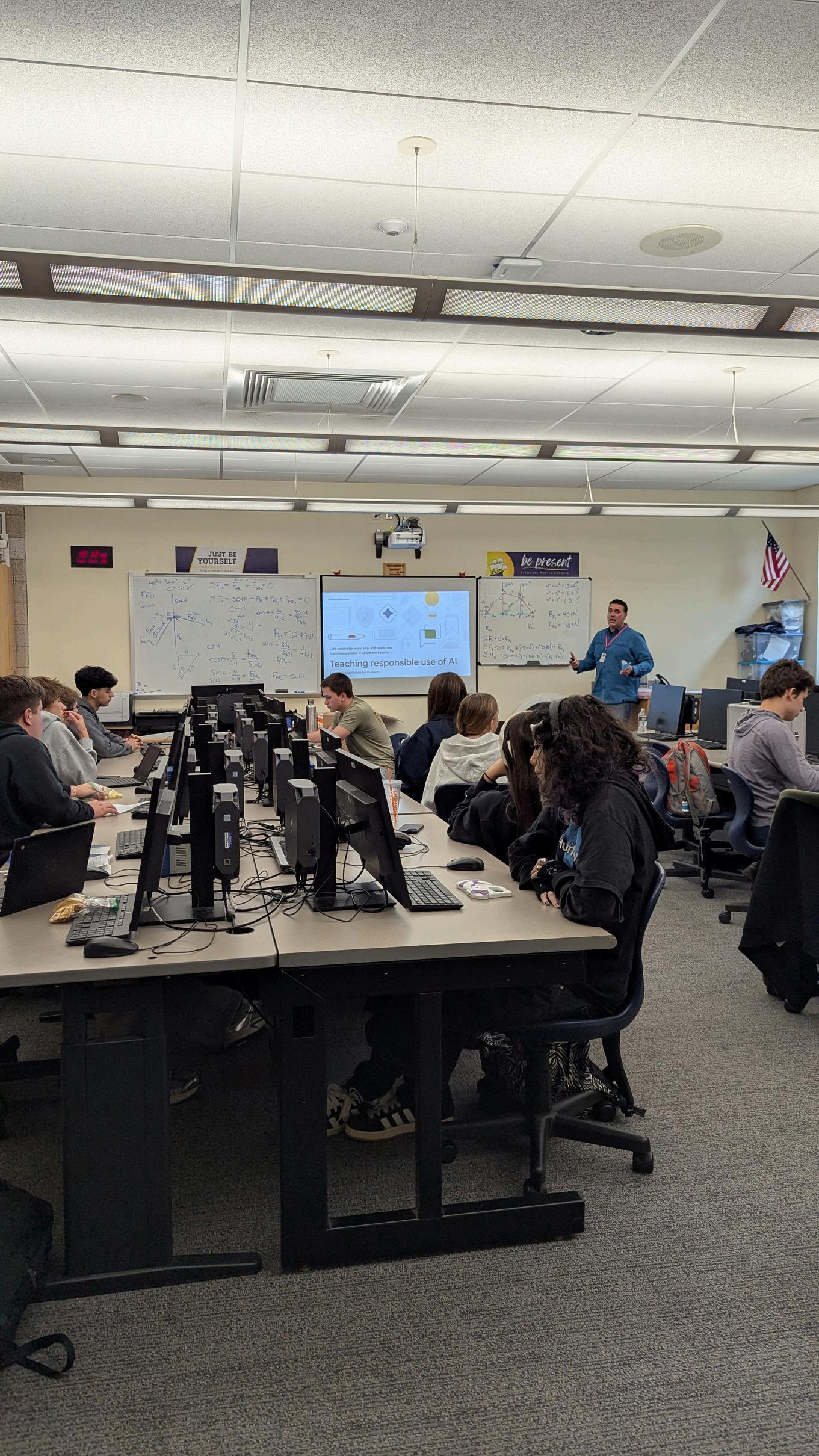
Many educators agree that as long as people are cautious, Gemini can be a useful tool
“I think it's important to learn about things first If you’re using it to take shortcuts that's not good, in that sense you're abusing it,” said Mr John Kowalski, Science teacher at North
The incoming Google Gemini resource is made to aid students and teachers alike in furthering education As long as artificial intelligence is used ethically and responsibly by students Google Gemini has the potential to become a permanent tool in the future
Mr Davis teaching an Exploring Education class
VHS student Fanoula Venetis checking her online assignments
An exploration of how the increased use of Artificial Intelligence affects the worldly environment; is it really worth it?
By Maya Salamone
A Coding the Climate: AI’s Environmental Tradeoffs
s AI reshapes the technological sector of the world, its environmental footprint is also growing concerningly fast From the industrial revolution AI has brought to the forefront to the potential harms of environmental impact AI has become a growing topic of discourse between legislations, communities, and one-on-one conversations
AI, or artificial intelligence, has seen a rampant increase in usage throughout the past couple of years whether it be for little things throughout daily life or implementing the usage into workplaces and schools However, it takes massive amounts of energy to power these data centers consuming great amounts of fossil fuels and increasing more harmful carbon emissions into the atmosphere This contaminates the air, water, and land which therefore affects the lives of billions of living organisms
According to the Natural Resources Defense Council, currently, AI data centers account for 21% of the world’s energy demand With this increased demand for energy, more nonenvironmentally friendly energy sources are being exploited
“Many AI data centers currently use a constant supply of energy that requires some utility companies to keep old,
SOth e



uneconomic coal plants open past their planned retirement,” Ella Lane, administrative coordinator for the content team at the Natural Resources Defense Council said “This could mean more power outages, higher electricity bills, and increased pollution
With the increased energy demand, not only are these tech companies facing the repercussions, but everyday Americans are as well The misuse of nonrenewable resources not only harms the environment, but also the human population living in that environment
Too much carbon dioxide in the atmosphere acts as a thermal blanket, trapping heat and leading to global warming
With this comes a greater shortage of sustainable weather and environments for important crops needed for human consumption and plants needed to produce oxygen for the livelihood of all mammals
“The emissions from that energy [AI data centers] is the real concern, Sustainable Plymouth s Mellisa Burridge said “We want that energy to be coming from sustainable sources and a lot of it right now is coming from coal and oil ”
National Geographic also outlines how the consumption of nonrenewable resources for energy purposes results in these resources running dry; they are unable to be replenished
The primary concern held by environmental advocates and organizations focuses on how AI negatively affects the environment yet many believe that it could actually help combat climate change With this in mind, artificial intelligence may have enough potential benefits to outweigh the detriments
According to researchers at John Hopkins University, different
organizations are using AI to make more informed decisions about the future changes in the environment, which would therefore help with the distribution of aid and preventative measures earlier on Rather than furthering the damage done by global warming and climate change AI has the potential to prevent it
“While the energy cost is real, it's vital to recognize that the technology is also being used to solve large-scale environmental and societal problems Coordinator of Educational Technology for Plymouth Public Schools Joli Boucher said “Google mentioned they use AI to predict or monitor natural disasters support healthcare innovations and reduce traffic to lower vehicle emissions ”
Currently, technological companies and environmental agencies often find themselves in conflict, with little willingness to consider the other side s perspective In order for the environment to be protected and cared for in the best way possible, a middle ground must be found between AI’s usage and its detrimental effects on carbon emissions and energy sources It is true that AI has great potential but the question that remains is how to regulate that potential to prevent any further environmental damage
Swap, don't shop! Plymouth turns trash into treasure
Plymouth's new Swap Shop invites our community to share gently used household items instead of tossing them out, transforming waste reduction into a town-wide act of sustainability
ustainable Plymouth’s Swap Shop represents the flourishing local movement towards eco-friendly living and waste reduction Beyond just saving money, by shopping at Plymouth's local swap shop you are also saving the planet
The shop first opened on Saturday the 27th of September with the goal of encouraging residents to give a new life to pre-loved items From kitchenware to books and toys, the shop fosters a circular economy that reduces waste and promotes mindful consumption It is a simple model; take what you need, leave what you don't, and keep perfectly useful items out of the landfill
Ken Stone, a member of the Advisory Board for Sustainable Plymouth, helped bring the idea of the Swap Shop to life His longstanding belief that “landfills are not a sustainable solution” inspired him to turn that conviction into action After witnessing for years how much reusable material ended up in the trash he decided he needed to see a meaningful change and began working with fellow volunteers to design this alternative Mrs Aminta Seery, the teacher responsible at Plymouth North staff for running our own clothing Swap Shop, the Eagles Nest, is also a volunteer for Sustainable Plymouth and volunteers during her free time on Saturdays at the swap shop
“It’s basically a free thrift store,” Mrs Seery said
By Grace Lamoureux

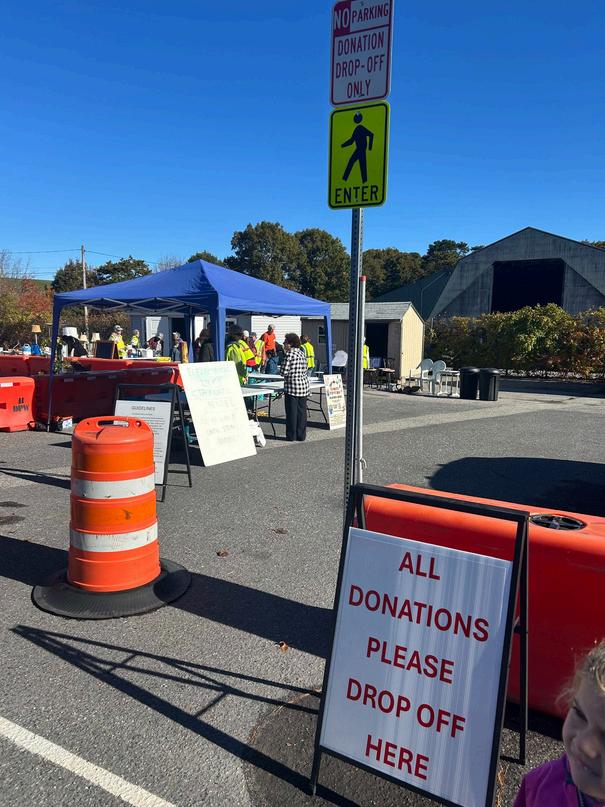



Her experience volunteering with Sustainable Plymouth stemmed from the Eagles Nest
“It is just clothes, but I often get offered other items that I won't take, but would be accepted at the swap shop,” said Mrs Seery The two shops have started working together to provide for the Plymouth community
Members of the community have started to see the swap shops success as donations continue to circulate out of the shop Ran by volunteers, the shop is always looking for an extra helping hand
Plymouth North student and volunteer Sophia Fox said, “Helping the environment is always something I have been passionate about, and being a volunteer is a rewarding way to do so ”
As a member of the National Honor Society, Fox is able to obtain community service hours doing something she loves A typical shift of a volunteer is from 8:30 am to 12:30 pm as the shop itself is open from 9-12
While the Swap Shop officially closed the last weekend of October, it will be open December 13th and 20 to provide some holiday options th
It will reopen in the Spring and hopes to bring together the Plymouth community’s growing shift towards sustainable living and shared responsibility By giving items a second life and reducing the need for new consumption, the Swap Shop is empowering Plymouth to be a part of a circular economy that values reuse over waste As more people begin to embrace this impact the shop stands as a reminder that small, local actions can lead to a meaningful change
Photos taken by Aminta Seery
